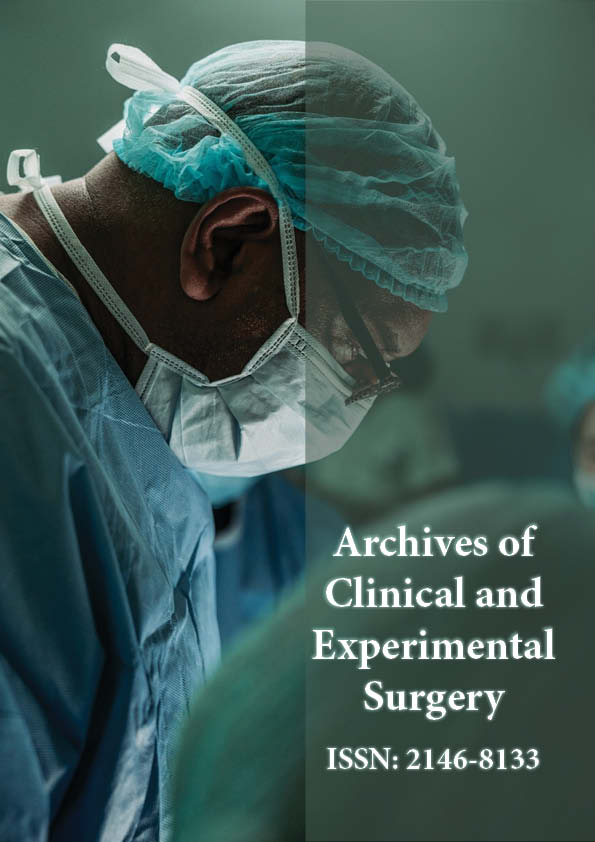Opinion Article - Archives of Clinical and Experimental Surgery (2022)
Surgical Techniques and Complications Associated with Aortic Surgery
Reka Gerd*Reka Gerd, Department of Surgery, University of Maiduguri, Maiduguri, Nigeria, Email: Rekag@gmail.com
Received: 27-Jun-2022, Manuscript No. EJMACES-22-69941; Editor assigned: 30-Jun-2022, Pre QC No. EJMACES-22-69941 (PQ); Reviewed: 15-Jul-2022, QC No. EJMACES-22-69941; Revised: 21-Jul-2022, Manuscript No. EJMACES-22-69941 (R); Published: 29-Jul-2022
Description
An abdominal, thoracic, or retroperitoneal surgical incision is used in Open Aortic Surgery (OAS), also known as Open Aortic Repair (OAR), to visualise and control the aorta for treatment purposes. Typically, the damaged segment is replaced with a prosthetic graft. OAS is used to treat aortic ruptures, aortic dissections, acute aortic syndrome, and abdominal and thoracic aortic aneurysms [1]. Treatment for atherosclerotic disease of the abdominal aorta below the level of the renal arteries also involves an aortobifemoral bypass. The most popular method for treating abdominal aortic aneurysms in the United States in 2003 was Endo Vascular Aneurysm Repair (EVAR), which replaced Open Abdominal Surgery (OAS) [2].
An open aortic procedure may be referred to as an infrarenal aortic repair, a thoracic aortic repair, or a thoracoabdominal aortic repair, depending on how much of the aorta is repaired. An isolated infrarenal or thoracic aortic repair is less invasive than a thoracoabdominal aortic repair.
OAS is different from aortic valve replacement and repair since it refers to aorta surgery rather than heart valve surgery. The Bentall treatment is utilised to treat the whole aortic root when the aortic valve is also damaged in addition to the ascending aorta [3]. Although it is used to treat aortic disease, an axillary-bifemoral bypass is not genuine open aortic surgery because it reconstructs the blood supply to the legs from the arm, rather than in the native location of the aorta. OAS is used to treat aortic aneurysms larger than 5.5 cm in diameter, aortic rupture of any size, aortic dissections, and acute aortic syndrome in patients. Infrarenal aneurysms, juxta- and pararenal aneurysms, thoracic and thoracoabdominal aneurysms, as well as non-aneurysmal aortic disease are all treated with it. Cardiothoracic surgery is the specialty that deals with diseases of the aorta that are close to the left subclavian artery. Valve-sparing aortic root replacement is one operation used to treat these diseases.
Techniques
A synthetic (Dacron or Gore-Tex) graft is normally inserted once the dilated part of the aorta is exposed during open surgery (tube). The aneurysmal sac is closed around the graft after it has been stitched into the proximal (toward the patient’s head) and distal (toward the patient’s foot) sections of the aorta. As an alternative, expandable devices can be used to perform the anastomosis, which is a quicker and easier process [4].
During open surgery, the aorta and its branched arteries are cross-clamped. When treating thoracic aneurysms, this can result in a spinal cord injury that causes paraplegia due to insufficient blood flow. Cerebrospinal fluid drainage, when carried out in skilled institutions, lowers the risk of ischemic spinal cord injury by raising the perfusion pressure to the spinal cord, according to a 2004 systematic review and meta- analysis. A 2012 Cochrane systematic review indicated that additional study is needed to determine whether CFSD is beneficial at avoiding spinal cord injuries.
Risks and complications
It is well known that endovascular operations for equivalent portions of the aorta have lower rates of perioperative morbidity and mortality than OAS. For instance, perioperative mortality with endovascular surgery is only 0.5% compared to 3% with surgical treatment in infrarenal aneurysms [5,6]. Depending on the segment of the aorta involved, there are additional risks and complications associated with OAS in addition to the potential for death, such as renal failure, paralysis from spinal cord ischemia, buttock claudication, ischemic colitis, acute limb ischemia from embolization, infection, and bleeding.
References
- Sethi RK, Henry AJ, Hevelone ND, Lipsitz SR, Belkin M, Nguyen LL, et al. Impact of hospital market competition on endovascular aneurysm repair adoption and outcomes. J Vasc Surg 2013;58(3):596-606.
[Crossref] [Google Scholar] [Pubmed]
- Coselli JS, LeMaire SA. Tips for successful outcomes for descending thoracic and thoracoabdominal aortic aneurysm procedures. Semin Vasc Surg 2008; 21(1):13–20.
- Crawford ES. Thoraco-abdominal and abdominal aortic aneurysms involving renal, superior mesenteric, celiac arteries. Ann Surg 1974; 179(5):763-72.
[Crossref] [Google Scholar] [Pubmed]
- Lederle FA, Freischlag JA, Kyriakides TC, Matsumura JS, Padberg Jr FT, Kohler TR, et al. Long-term comparison of endovascular and open repair of abdominal aortic aneurysm. N Engl J Med 2012; 367:1988-97.
- Safi HJ, Estrera AL, Azizzadeh A, Coogan S, Miller CC. Progress and future challenges in thoracoabdominal aortic aneurysm management. World J Surg 2008; 32(3):355-60.
- Safi HJ, Miller CC. Spinal cord protection in descending thoracic and thoracoabdominal aortic repair. Ann Thorac Surg 1999; 67(6):1937-9.
Copyright: © 2022 The Authors. This is an open access article under the terms of the Creative Commons Attribution NonCommercial ShareAlike 4.0 (https://creativecommons.org/licenses/by-nc-sa/4.0/). This is an open access article distributed under the terms of the Creative Commons Attribution License, which permits unrestricted use, distribution, and reproduction in any medium, provided the original work is properly cited.







